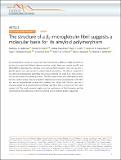The structure of a β2-microglobulin fibril suggests a molecular basis for its amyloid polymorphism
Author(s)
Iadanza, Matthew G.; Boardman, Joshua; Smith, Hugh I.; Karamanos, Theodoros K.; Ranson, Neil A.; Radford, Sheena E.; Silvers, Robert Paul Georg; Debelouchina, Galia Tzvetanova; Su, Yongchao; Griffin, Robert Guy; ... Show more Show less
Downloads41467-018-06761-6.pdf (4.036Mb)
PUBLISHER_CC
Publisher with Creative Commons License
Creative Commons Attribution
Terms of use
Metadata
Show full item recordAbstract
All amyloid fibrils contain a cross-β fold. How this structure differs in fibrils formed from proteins associated with different diseases remains unclear. Here, we combine cryo-EM and MAS-NMR to determine the structure of an amyloid fibril formed in vitro from β2-microglobulin (β2m), the culprit protein of dialysis-related amyloidosis. The fibril is composed of two identical protofilaments assembled from subunits that do not share β2m's native tertiary fold, but are formed from similar β-strands. The fibrils share motifs with other amyloid fibrils, but also contain unique features including π-stacking interactions perpendicular to the fibril axis and an intramolecular disulfide that stabilises the subunit fold. We also describe a structural model for a second fibril morphology and show that it is built from the same subunit fold. The results provide insights into the mechanisms of fibril formation and the commonalities and differences within the amyloid fold in different protein sequences.
Date issued
2018-10Department
Massachusetts Institute of Technology. Department of Chemistry; Francis Bitter Magnet Laboratory (Massachusetts Institute of Technology)Journal
Nature Communications
Publisher
Nature Publishing Group
Citation
Iadanza, Matthew G. et al. “The Structure of a Β2-Microglobulin Fibril Suggests a Molecular Basis for Its Amyloid Polymorphism.” Nature Communications 9, no. 1 (October 30, 2018). © 2019 Springer Nature Publishing AG
Version: Final published version
ISSN
2041-1723